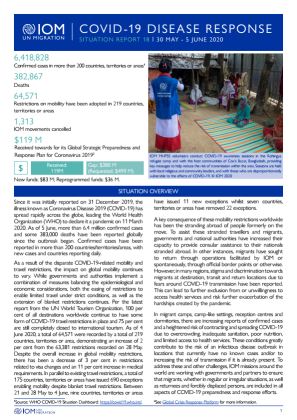-
Countries
-
Data and Analysis
-
Special Focus
-
Crisis Responses
IOM COVID 19 Response - Situation Report 18 (5 June 2020)

Contacter
COVID Response HQ - covid19ops@iom.int
Langue
English
Emplacement
Global
Période couverte
May 30 2020
Jun 05 2020
Activité
- Other
- Points of Entry (PoE)
Since it was initially reported on 31 December 2019, the illness known as Coronavirus Disease 2019 (COVID-19) has spread rapidly across the globe, leading the World Health Organization (WHO) to declare it a pandemic on 11 March 2020. As of 5 June, more than 6.4 million confirmed cases and some 383,000 deaths have been reported globally since the outbreak began. Confirmed cases have been reported in more than 200 countries/territories/areas, with new cases and countries reporting daily.
As a result of the disparate COVID-19-related mobility and travel restrictions, the impact on global mobility continues to vary. While governments and authorities implement a combination of measures balancing the epidemiological and economic considerations, both the easing of restrictions to enable limited travel under strict conditions, as well as the extension of blanket restrictions continues. Per the latest report from the UN World Tourism Organization, 100 per cent of all destinations worldwide continue to have some form of COVID-19 travel restrictions in place and 75 per cent are still completely closed to international tourism. As of 4 June 2020, a total of 64,571 were recorded by a total of 219 countries, territories or area, demonstrating an increase of 2 per cent from the 63,381 restrictions recorded on 28 May. Despite the overall increase in global mobility restrictions, there has been a decrease of 3 per cent in restrictions related to visa changes and an 11 per cent increase in medical requirements. In parallel to existing travel restrictions, a total of 175 countries, territories or areas have issued 690 exceptions enabling mobility despite blanket travel restrictions. Between 21 and 28 May to 4 June, nine countries, territories or areas have issued 11 new exceptions whilst seven countries, territories or areas have removed 22 exceptions.
A key consequence of these mobility restrictions worldwide has been the stranding abroad of people formerly on the move. To assist these stranded travellers and migrants, governments and national authorities have increased their capacity to provide consular assistance to their nationals stranded abroad. In other instances, migrants have sought to return through operations facilitated by IOM or spontaneously, through official border points or otherwise. However, in many regions, stigma and discrimination towards migrants at destination, transit and return locations due to fears around COVID-19 transmission have been reported. This can lead to further exclusion from or unwillingness to access health services and risk further exacerbation of the hardships created by the pandemic.
In migrant camps, camp-like settings, reception centres and dormitories, there are increasing reports of confirmed cases and a heightened risk of contracting and spreading COVID-19 due to overcrowding, inadequate sanitation, poor nutrition, and limited access to health services. These conditions greatly contribute to the risk of an infectious disease outbreak in locations that currently have no known cases and/or to increasing the risk of transmission if it is already present. To address these and other challenges, IOM missions around the world are working with governments and partners to ensure that migrants, whether in regular or irregular situations, as well as returnees and forcibly displaced persons, are included in all aspects of COVID-19 preparedness and response efforts.
